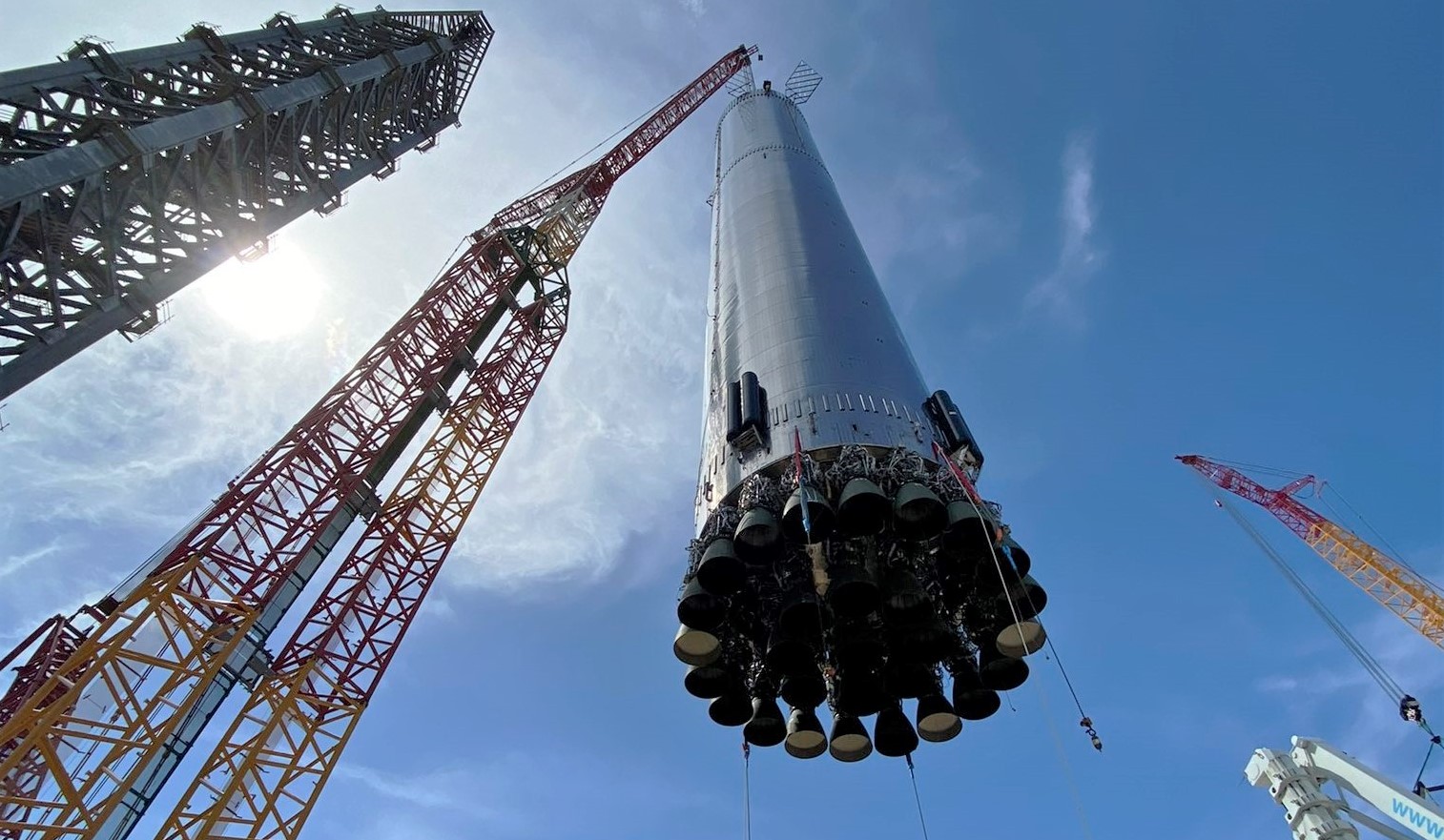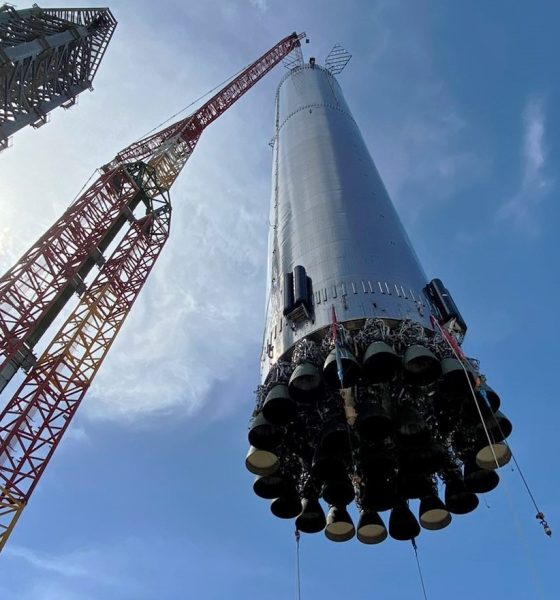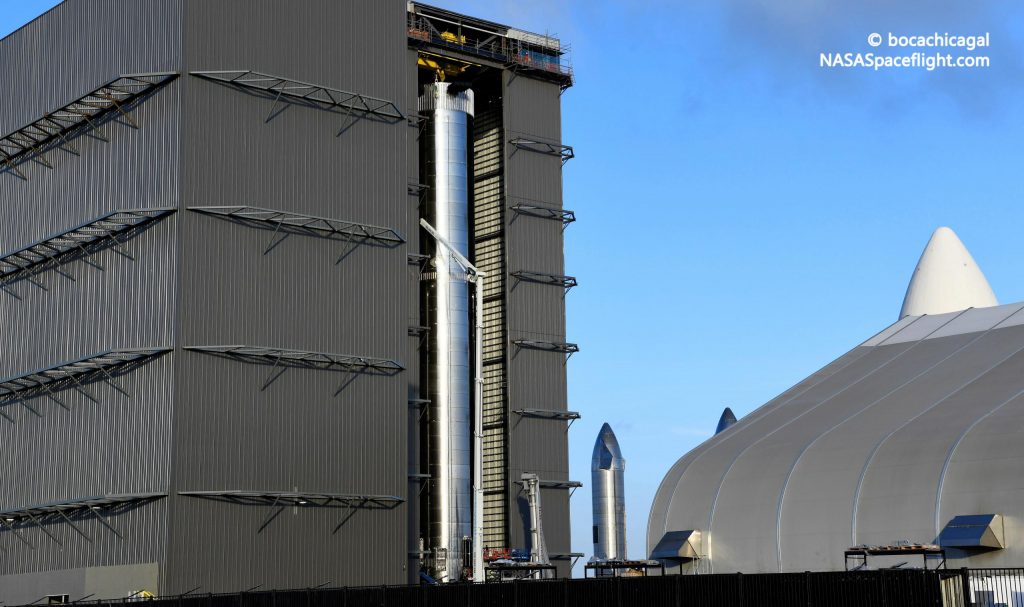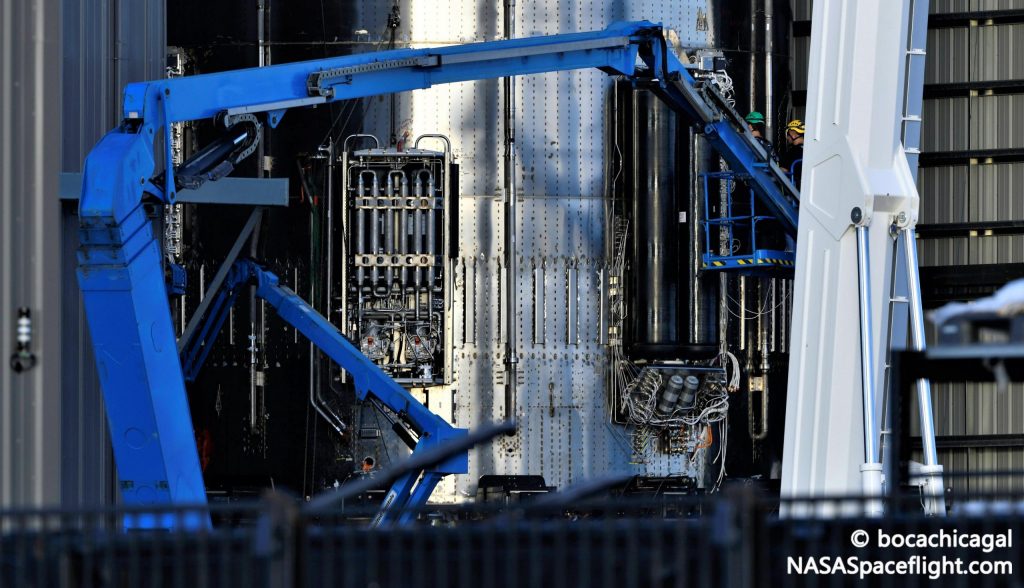

News
SpaceX reinstalling 29 Raptor engines on first orbital-class Starship booster
For the second time this month, SpaceX has begun installing 29 Raptor engines on Starship’s first orbital-class Super Heavy booster, potentially paving the way for several crucial milestones.
On August 1st, around the same time as SpaceX finished installing car-sized grid fins on a Super Heavy for the first time, the company began the process of installing multiple Raptor engines on the booster (#4) that might one day support Starship’s first orbital launch attempt. Not long after it began, it became clear that SpaceX was installing a full 29 Raptor engines on Booster 4 (B4) at a breakneck pace, and less than 24 hours later, all had been attached to Super Heavy’s thrust structure.
Barely a day later, Super Heavy Booster 4 was rolled to the orbital launch pad and installed on a massive ‘launch table’ that was itself installed just a few days prior after months of assembly. Four days after engine installation, Starship S20 and Booster 4 were briefly mated together, forming a full Starship stack – the tallest and most powerful rocket ever built – for about an hour. However, while it did serve as a useful learning experience and pathfinder operation, both stages were demated and returned to the factory soon after.
Since Booster 4’s later August 11th build site return, SpaceX teams have been hard at work fitting the massive 69m (225 ft) tall rocket booster with thousands of feet (if not miles) of secondary plumbing and power and avionics cables. That process effectively began with removing the Super Heavy’s 29 Raptor engines, which finished just a few days after its return to the high bay.


Now, just 12 days after Super Heavy Booster 4 arrived back at the high bay and 11 days after workers briskly removed its Raptors, SpaceX has begun the process of reinstalling those engines – albeit with several new entrants this time around. When SpaceX first fitted B4 with Raptors, it became clear that five or more of had never been tested, making the removal of some of the Super Heavy’s 29 engines more or less inevitable. Indeed, as expected, several new Raptors (engines that weren’t clearly installed the first time around) have joined around two dozen engines that were installed earlier this month.
Given that Booster 4 has already completed a range of fit checks, the implication is that SpaceX is now installing the 29 Raptor engines that will support the first static fire test campaign of a flightworthy Super Heavy. Of course, that testing (likely involving several different static fires of an increasing number of Raptors) could unearth issues or even damage some of those 29 Raptors, so it isn’t quite accurate to say that Booster 4 is being fitted with the engines that will help it carry Starship to orbit. Depending on the outcome of those tests, though, most could easily find themselves lifting off on Super Heavy B4 later this year.
For now, though, Super Heavy Booster 4’s next milestone will be its second trip from the build site to the launch pad. That could occur at any point in the next week or two and could find Booster 4 installed beside Ship 20 on the second of two suborbital test stands, though the Super Heavy may instead return to the orbital launch site.

Investor's Corner
Tesla stock closes at all-time high on heels of Robotaxi progress

Tesla stock (NASDAQ: TSLA) closed at an all-time high on Tuesday, jumping over 3 percent during the day and finishing at $489.88.
The price beats the previous record close, which was $479.86.
Shares have had a crazy year, dipping more than 40 percent from the start of the year. The stock then started to recover once again around late April, when its price started to climb back up from the low $200 level.
This week, Tesla started to climb toward its highest levels ever, as it was revealed on Sunday that the company was testing driverless Robotaxis in Austin. The spike in value pushed the company’s valuation to $1.63 trillion.
Tesla Robotaxi goes driverless as Musk confirms Safety Monitor removal testing
It is the seventh-most valuable company on the market currently, trailing Nvidia, Apple, Alphabet (Google), Microsoft, Amazon, and Meta.
Shares closed up $14.57 today, up over 3 percent.
The stock has gone through a lot this year, as previously mentioned. Shares tumbled in Q1 due to CEO Elon Musk’s involvement with the Department of Government Efficiency (DOGE), which pulled his attention away from his companies and left a major overhang on their valuations.
However, things started to rebound halfway through the year, and as the government started to phase out the $7,500 tax credit, demand spiked as consumers tried to take advantage of it.
Q3 deliveries were the highest in company history, and Tesla responded to the loss of the tax credit with the launch of the Model 3 and Model Y Standard.
Additionally, analysts have announced high expectations this week for the company on Wall Street as Robotaxi continues to be the focus. With autonomy within Tesla’s sights, things are moving in the direction of Robotaxi being a major catalyst for growth on the Street in the coming year.
Elon Musk
Tesla needs to come through on this one Robotaxi metric, analyst says
“We think the key focus from here will be how fast Tesla can scale driverless operations (including if Tesla’s approach to software/hardware allows it to scale significantly faster than competitors, as the company has argued), and on profitability.”

Tesla needs to come through on this one Robotaxi metric, Mark Delaney of Goldman Sachs says.
Tesla is in the process of rolling out its Robotaxi platform to areas outside of Austin and the California Bay Area. It has plans to launch in five additional cities, including Houston, Dallas, Miami, Las Vegas, and Phoenix.
However, the company’s expansion is not what the focus needs to be, according to Delaney. It’s the speed of deployment.
The analyst said:
“We think the key focus from here will be how fast Tesla can scale driverless operations (including if Tesla’s approach to software/hardware allows it to scale significantly faster than competitors, as the company has argued), and on profitability.”
Profitability will come as the Robotaxi fleet expands. Making that money will be dependent on when Tesla can initiate rides in more areas, giving more customers access to the program.
There are some additional things that the company needs to make happen ahead of the major Robotaxi expansion, one of those things is launching driverless rides in Austin, the first city in which it launched the program.
This week, Tesla started testing driverless Robotaxi rides in Austin, as two different Model Y units were spotted with no occupants, a huge step in the company’s plans for the ride-sharing platform.
Tesla Robotaxi goes driverless as Musk confirms Safety Monitor removal testing
CEO Elon Musk has been hoping to remove Safety Monitors from Robotaxis in Austin for several months, first mentioning the plan to have them out by the end of 2025 in September. He confirmed on Sunday that Tesla had officially removed vehicle occupants and started testing truly unsupervised rides.
Although Safety Monitors in Austin have been sitting in the passenger’s seat, they have still had the ability to override things in case of an emergency. After all, the ultimate goal was safety and avoiding any accidents or injuries.
Goldman Sachs reiterated its ‘Neutral’ rating and its $400 price target. Delaney said, “Tesla is making progress with its autonomous technology,” and recent developments make it evident that this is true.
Investor's Corner
Tesla gets bold Robotaxi prediction from Wall Street firm
Last week, Andrew Percoco took over Tesla analysis for Morgan Stanley from Adam Jonas, who covered the stock for years. Percoco seems to be less optimistic and bullish on Tesla shares, while still being fair and balanced in his analysis.

Tesla (NASDAQ: TSLA) received a bold Robotaxi prediction from Morgan Stanley, which anticipates a dramatic increase in the size of the company’s autonomous ride-hailing suite in the coming years.
Last week, Andrew Percoco took over Tesla analysis for Morgan Stanley from Adam Jonas, who covered the stock for years. Percoco seems to be less optimistic and bullish on Tesla shares, while still being fair and balanced in his analysis.
Percoco dug into the Robotaxi fleet and its expansion in the coming years in his latest note, released on Tuesday. The firm expects Tesla to increase the Robotaxi fleet size to 1,000 vehicles in 2026. However, that’s small-scale compared to what they expect from Tesla in a decade.
Tesla expands Robotaxi app access once again, this time on a global scale
By 2035, Morgan Stanley believes there will be one million Robotaxis on the road across multiple cities, a major jump and a considerable fleet size. We assume this means the fleet of vehicles Tesla will operate internally, and not including passenger-owned vehicles that could be added through software updates.
He also listed three specific catalysts that investors should pay attention to, as these will represent the company being on track to achieve its Robotaxi dreams:
- Opening Robotaxi to the public without a Safety Monitor. Timing is unclear, but it appears that Tesla is getting closer by the day.
- Improvement in safety metrics without the Safety Monitor. Tesla’s ability to improve its safety metrics as it scales miles driven without the Safety Monitor is imperative as it looks to scale in new states and cities in 2026.
- Cybercab start of production, targeted for April 2026. Tesla’s Cybercab is a purpose-built vehicle (no steering wheel or pedals, only two seats) that is expected to be produced through its state-of-the-art unboxed manufacturing process, offering further cost reductions and thus accelerating adoption over time.
Robotaxi stands to be one of Tesla’s most significant revenue contributors, especially as the company plans to continue expanding its ride-hailing service across the world in the coming years.
Its current deployment strategy is controlled and conservative to avoid any drastic and potentially program-ruining incidents.
So far, the program, which is active in Austin and the California Bay Area, has been widely successful.








